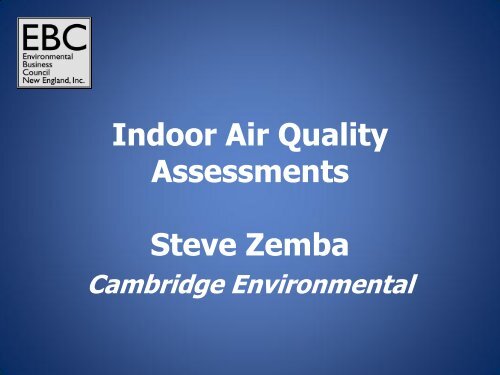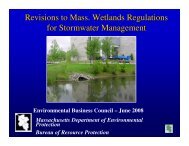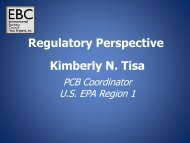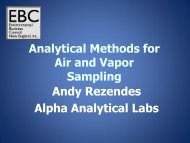Indoor Air Quality Assessments Steve Zemba
Indoor Air Quality Assessments Steve Zemba
Indoor Air Quality Assessments Steve Zemba
You also want an ePaper? Increase the reach of your titles
YUMPU automatically turns print PDFs into web optimized ePapers that Google loves.
<strong>Indoor</strong> <strong>Air</strong> <strong>Quality</strong><br />
<strong>Assessments</strong><br />
<strong>Steve</strong> <strong>Zemba</strong><br />
Cambridge Environmental
Health Risk Assessment Perspectives<br />
on PCBs in Building Materials and<br />
<strong>Indoor</strong> <strong>Air</strong><br />
Stephen G. <strong>Zemba</strong>, Ph.D., P.E.<br />
(<strong>Zemba</strong>@CambridgeEnvironmental.com)<br />
Cambridge Environmental Inc<br />
58 Charles Street Cambridge, Massachusetts 02141<br />
Phone: 617-225-0810 www.CambridgeEnvironmental.com
Overview<br />
• PCBs synthesized 1929, used in >1,000 products<br />
• Massive occupational exposures (1930’s & 40’s) caused:<br />
– liver failure and chloracne<br />
– but not cancer (Golden & Kimbrough, 2009)<br />
• Standards and guidelines<br />
– OSHA PELs: 500,000 – 1,000,000 ng/m 3<br />
– U.S. EPA Schools: 70 – 600 ng/m 3<br />
Cambridge Environmental Inc 3 www.CambridgeEnvironmental.com
<strong>Indoor</strong> <strong>Air</strong> Screening Levels<br />
EPA’s Recommended Public Health Levels of PCBs in School<br />
<strong>Indoor</strong> <strong>Air</strong> (ng/m 3 )<br />
(www.epa.gov/pcbsincaulk/maxconcentrations.pdf)<br />
Age 1-
PCB Concentrations in <strong>Indoor</strong> <strong>Air</strong><br />
Table 2 PCB Concentrations Detected in Schools (as<br />
obtained from Internet sources or personal communication)<br />
Location<br />
Date Concentrations<br />
(in ng/m 3 )<br />
Lederle Center, U-Mass Amherst 2006 220 – 640<br />
Estabrook School, Lexington, MA 2010 300 – 1,800<br />
Burke School, Peabody, MA 2011 260 – 740<br />
New Bedford (MA) High School 2011 3 – 1,450<br />
Boston (MA) Day Care Center 2012 110 – 200<br />
Cambridge Environmental Inc 5 www.CambridgeEnvironmental.com
PCB28<br />
PCB52<br />
PCB66<br />
PCB74<br />
PCB77 *<br />
PCB81 *<br />
PCB99<br />
PCB101<br />
PCB105 *<br />
PCB114 *<br />
PCB118 *<br />
PCB123 *<br />
PCB126 *<br />
PCB138<br />
PCB153<br />
PCB156 *<br />
PCB157 *<br />
PCB167 *<br />
PCB169 *<br />
PCB170<br />
PCB180<br />
PCB183<br />
PCB187<br />
PCB189 *<br />
Aroclor 1254 (%)<br />
PCB in Caulk (mg/kg)<br />
PCB in <strong>Indoor</strong> <strong>Air</strong> (ng/m 3 *100)<br />
9<br />
8<br />
7<br />
6<br />
5<br />
4<br />
3<br />
2<br />
1<br />
0<br />
PCBs in Denmark Homes<br />
Danish Health Protection Agency, 2012<br />
• 83 PCB-contaminated apartments<br />
• 27 congeners in caulking, indoor air, & serum<br />
• Plotted against Aroclor 1254 composition<br />
16000<br />
14000<br />
12000<br />
10000<br />
8000<br />
6000<br />
4000<br />
2000<br />
0<br />
Aroclor 1254 Caulking <strong>Indoor</strong> <strong>Air</strong><br />
Cambridge Environmental Inc 6 www.CambridgeEnvironmental.com
Mass Percentage of Aroclor<br />
PCB Homologue Groups in <strong>Indoor</strong> <strong>Air</strong><br />
Massachusetts Schools<br />
70%<br />
60%<br />
50%<br />
40%<br />
30%<br />
20%<br />
10%<br />
0%<br />
1 2 3 4 5 6 7 8 9 10<br />
Homolgue Group (Chlorine # in Congerers)<br />
Burke School Boston Child Care Estabrook School<br />
New Bedford HS Aroclor 1254<br />
Cambridge Environmental Inc 7 www.CambridgeEnvironmental.com
Toxicological Values for Risk Assessment<br />
• From U.S. EPA’s IRIS database<br />
– Carcinogenic Potencies<br />
• 1 to 2 kg-day/mg (high-risk/persistence)<br />
• 0.3 to 0.4 kg-day/mg (low- risk/persistence)<br />
– “Non-cancer” Reference Doses<br />
• 20 ng/kg-day Aroclor 1254<br />
• 70 ng/kg-day Aroclor 1016<br />
• 0.0007 ng/kg-day 2,3,7,8-TCDD<br />
• Alternative Approach (Simon 2007)<br />
– Neurological Equivalents<br />
• 8 ng/kg-d Aroclor 1254<br />
• 70 ng/kg-d Aroclor 1016<br />
Cambridge Environmental Inc 8 www.CambridgeEnvironmental.com
Case Study: “Brownfield” Redevelopment<br />
• Mill building conversion to condominiums<br />
– PCB-impregnated floors<br />
– Renovation workers at risk?<br />
• Exposure estimate<br />
– Assume 3.3 mg/m 3 of dust (high level)<br />
– 5.8 mg/kg PCB in dust<br />
– yields exposure to 0.02 μg/m 3 of PCBs<br />
• Acceptable/safe levels<br />
– OSHA PEL: 500 μg/m 3<br />
– More recent studies: 10 μg/m 3 (= 10,000 ng/m 3 )<br />
Cambridge Environmental Inc 9 www.CambridgeEnvironmental.com
Case Study: Child Care Center<br />
• PCB concentrations in indoor air<br />
– 110 – 200 ng/m 3 now<br />
– > 300 ng/m 3 previously<br />
– Exceed EPA guideline of 70 ng/m 3 for 1-2 and 2-3 yr olds<br />
• Questions<br />
– Should center be closed?<br />
– What about < 1 yr-olds?<br />
• Issues and perspectives<br />
– Homologue profile resembles Aroclor 1254<br />
– EPA guidelines derive from toxicity study in monkeys<br />
• Safety factor of 250 applied<br />
• Humans may be less sensitive to PCBs than monkeys<br />
– Nursing infants receive ~ 20 times more exposure than EPA’s<br />
Reference Dose<br />
Cambridge Environmental Inc 10 www.CambridgeEnvironmental.com
Conclusions<br />
• Levels of PCBs measured in indoor air due to building<br />
material sources have been near or greater than recommended<br />
exposure levels<br />
• Actual risks to health may be substantially overestimated (or<br />
conversely, exposure guidelines are highly protective)<br />
• PCBs found in indoor air emphasize the less chlorinated, and<br />
generally less toxic, congeners of the parent mixtures<br />
• PCBs are most likely not as toxic as guidelines imply<br />
• PCB risk assessment methods are uncertain, could be<br />
improved, and will likely evolve<br />
Cambridge Environmental Inc 11 www.CambridgeEnvironmental.com


